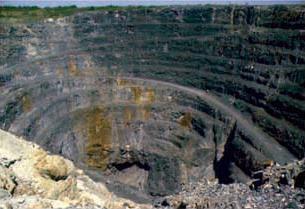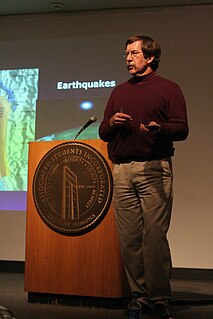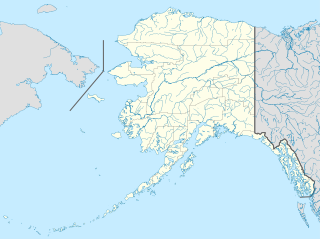Related Research Articles

Ore is natural rock or sediment that contains one or more valuable minerals, typically containing metals, that can be mined, treated and sold at a profit. Ore is extracted from the earth through mining and treated or refined, often via smelting, to extract the valuable metals or minerals. The grade of ore refers to the concentration of the desired material it contains. The value of the metals or minerals a rock contains must be weighed against the cost of extraction to determine whether it is of sufficiently high grade to be worth mining, and is therefore considered an ore.

Sphalerite is a sulfide mineral with the chemical formula (Zn,Fe)S and an ore of zinc. When the iron content is high, sphalerite is an opaque black variety called marmatite. German geologist Ernst Friedrich Glocker discovered sphalerite in 1847, naming it based on the Greek word sphaleros, meaning "deceiving", due to the difficulty of identifying the mineral. Sphalerite is found in association with galena, chalcopyrite, pyrite, calcite, dolomite, quartz, rhodochrosite, and fluorite. Miners have been known to refer to sphalerite as zinc blende, black-jack, and ruby blende. Sphalerite is found in a variety of deposit types, but it is primarily in sedimentary exhalative, Mississippi-Valley type, and volcanogenic massive sulfide deposits. It is used for zinc, brass, bronze, gemstones, galvanization, pharmaceuticals, and cosmetics.
Sedimentology encompasses the study of modern sediments such as sand, silt, and clay, and the processes that result in their formation, transport, deposition and diagenesis. Sedimentologists apply their understanding of modern processes to interpret geologic history through observations of sedimentary rocks and sedimentary structures.

Volcanogenic massive sulfide ore deposits, also known as VMS ore deposits, are a type of metal sulfide ore deposit, mainly copper-zinc which are associated with and created by volcanic-associated hydrothermal events in submarine environments.

Sedimentary exhalative deposits are zinc-lead deposits originally interpreted to have been formed by discharge of metal-bearing basinal fluids onto the seafloor resulting in the precipitation of mainly stratiform ore, often with thin laminations of sulphide minerals. SEDEX deposits are hosted largely by clastic rocks deposited in intracontinental rifts or failed rift basins and passive continental margins. Since these ore deposits frequently form massive sulfide lenses, they are also named sediment-hosted massive sulfide (SHMS) deposits, as opposed to volcanic-hosted massive sulfide (VHMS) deposits. The sedimentary appearance of the thin laminations led to early interpretations that the deposits formed exclusively or mainly by exhalative processes onto the seafloor, hence the term SEDEX. However, recent study of numerous deposits indicates that shallow subsurface replacement is also an important process, in several deposits the predominant one, with only local if any exhalations onto the seafloor. For this reason, some authors prefer the term "Clastic-dominated zinc-lead deposits". As used today, therefore, the term SEDEX is not to be taken to mean that hydrothermal fluids actually vented into the overlying water column, although this may have occurred in some cases

Waldemar Lindgren was a Swedish-American geologist. Lindgren was one of the founders of modern economic geology.

A polymetallic replacement deposit, also known as carbonate replacement deposit or high-temperature carbonate-hosted Ag-Pb-Zn deposit, is an orebody of metallic minerals formed by the replacement of sedimentary, usually carbonate rock, by metal-bearing solutions in the vicinity of igneous intrusions. When the ore forms a blanketlike body along the bedding plane of the rock, it is commonly called a manto ore deposit. Other ore geometries are chimneys and veins. Polymetallic replacements/mantos are often stratiform wall-rock replacement orebodies distal to porphyry copper deposits, or porphyry molybdenum deposits. The term manto is from the Spanish word for mantle, or cloak, although the geologic manto is more like a mantle roll than a sheetlike structure.
Anthony James "Tony" Naldrett, FRSC was an English and Canadian geologist. He was an authority on the geology and origin of nickel-copper-platinum group element deposits, the tectonic setting in which they occur, the petrology of associated rocks, and controls on their composition. He was an expert on the reaction between sulfide and silicate melts, fractional crystallization of sulfide melts, and the role of hydrothermal fluids.

John Joseph Clague PhD FRSC OC is a Canadian authority in Quaternary and environmental earth sciences. He is a Professor of Earth Sciences at Simon Fraser University and an Emeritus Scientist of the Geological Survey of Canada.

Carbonate-hosted lead-zinc ore deposits are important and highly valuable concentrations of lead and zinc sulfide ores hosted within carbonate formations and which share a common genetic origin.

The Broken Hill Ore Deposit is located underneath Broken Hill in western New South Wales, Australia, and is the namesake for the town. It is arguably the world's richest and largest zinc-lead ore deposit.

The Admiralty mining district is a mining area in the U.S. state of Alaska which consists of Admiralty Island. Silver and base metals are mined, with gold recovered as a by-product.

The Belt Supergroup is an assemblage of primarily fine-grained sedimentary rocks and mafic intrusive rocks of late Precambrian (Mesoproterozoic) age. It is more than 15 kilometres (10 mi) thick, covers an area of some 200,000 km2, and is considered to be one of the world's best-exposed and most accessible sequences of Mesoproterozoic rocks. It was named after the Big Belt Mountains in west-central Montana. It is present in western Montana and northern Idaho, with minor occurrences in northeastern Washington and western Wyoming. It extends into Canada where the equivalent rocks, which are called the Purcell Supergroup, are exposed in southeastern British Columbia and southwestern Alberta. The rocks of the Belt Supergroup contain economically significant deposits of lead, zinc, silver, copper, gold, and other metals in a number of areas, and some of the Belt rocks contain fossil stromatolites.

The Cathedral Formation is a stratigraphic unit in the southern Canadian Rockies of Alberta and British Columbia, on the western edge of the Western Canada Sedimentary Basin. It is a thick sequence of carbonate rocks of Middle Cambrian age. It was named for Cathedral Mountain in Yoho National Park by Charles Doolittle Walcott, the discoverer of the Burgess shale fossils.
The R.A.F. Penrose Gold Medal was established in 1923 and is awarded by the Society of Economic Geologists (SEG) to recognize a full career in the performance of "unusually original work in the earth sciences". The medal was donated by American geologist and founding President of the SEG Richard A.F. Penrose Jr. At the time of its donation, Penrose was explicit in his desire that the medal be awarded for achievements in pure geological science, rather than in the application of science to the discovery of mineral deposits.
The Purcell Supergroup is composed primarily of argillites, carbonate rocks, quartzites, and mafic igneous rocks of late Precambrian (Mesoproterozoic) age. It is present in an area of about 15,000 km2 in southwestern Alberta and southeastern British Columbia, Canada, and it extends into the northwestern United States where it is called the Belt Supergroup. It was named for the Purcell Mountains of British Columbia by R.A. Daly in 1912. Fossil stromatolites and algal structures are common in some of the Purcell Supergroup rocks, and the Sullivan ore body at Kimberley, British Columbia, a world-class deposit of lead, zinc, and silver, lies within the Alderidge Formation in the lower part of the Purcell.
Hydrothermal mineral deposits are accumulations of valuable minerals which formed from hot waters circulating in Earth's crust through fractures. They eventually create metallic-rich fluids concentrated in a selected volume of rock, which become supersaturated and then precipitate ore minerals. In some occurrences, minerals can be extracted at a profit by mining. Discovery of mineral deposits consumes considerable time and resources and only about one in every one thousand prospects explored by companies are eventually developed into a mine. A mineral deposit is any geologically significant concentration of an economically useful rock or mineral present in a specified area. The presence of a known but unexploited mineral deposit implies a lack of evidence for profitable extraction.

John Leslie Jambor was a Canadian geologist and mineralogist. Jambor was an exceptional figure in the field of mineralogy and a major contributor to the Mineralogical Association of Canada (MAC).
Jambor has a Scopus h-index of 38.
Massive sulfide deposits are ore deposits that have significant stratiform ore bodies consisting mainly of sulfide minerals. Most massive sulfide ore deposits have other portions that are not massive, including stringer or feeder zones beneath the massive parts that mostly consist of crosscutting veins and veinlets of sulfides in a matrix of pervasively altered host rock and gangue.
References
- ↑ Presidents and Vice Presidents of SEG Archived July 27, 2011, at the Wayback Machine
- ↑ SEG: Silver Medal Archived July 27, 2011, at the Wayback Machine